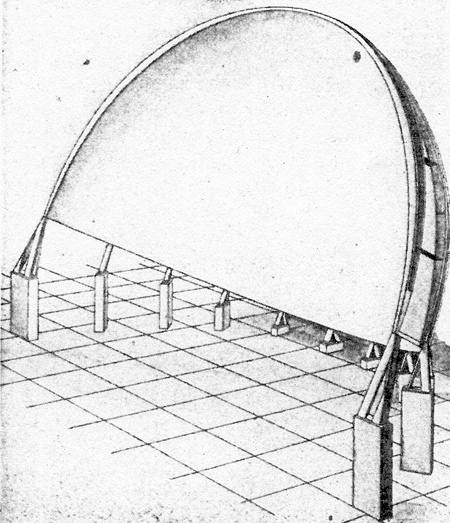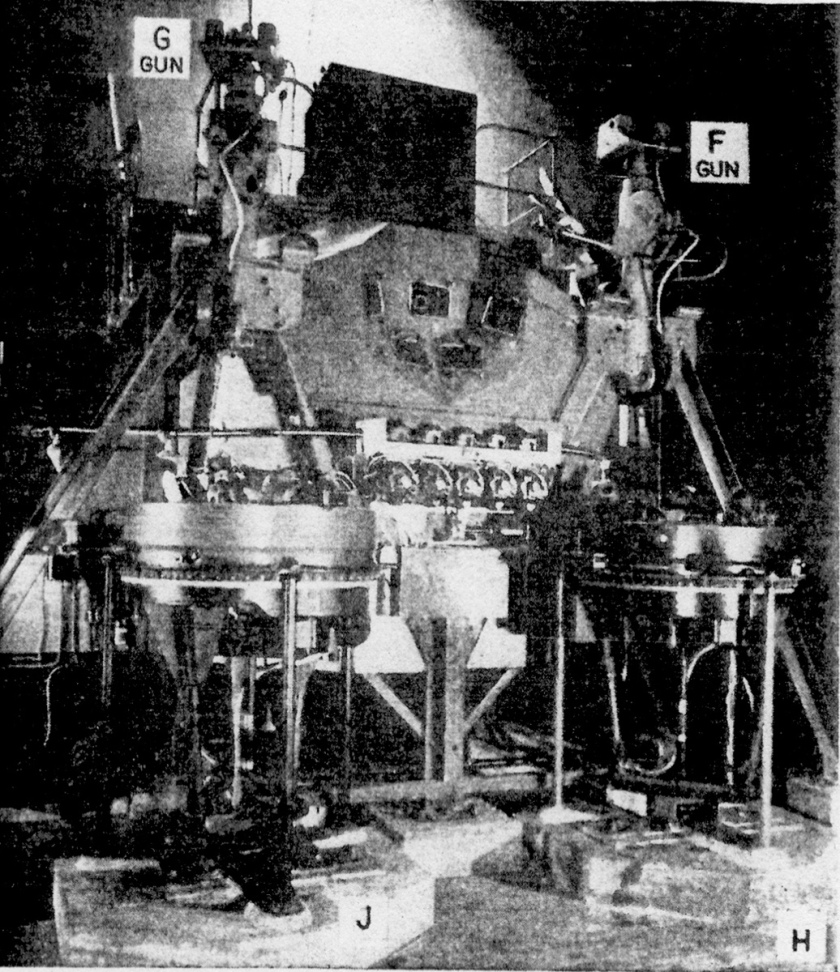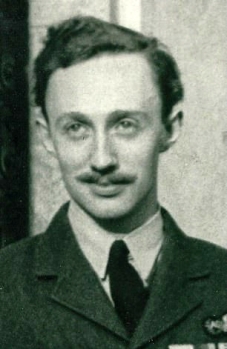Waller Flexible Gunnery Trainer
The September 1943 issue of Popular Science included an Article on Fred Waller’s innovative Gunnery Trainer. The Waller Gunnery Trainer was a Simulator for Training WW2 Air Gunners using multiple Film Projectors. Its inventor, Fred Waller, later invented the Cinerama Film Format. As the Special Projects Director for the 1939 New York World’s Fair, he collaborated on the Fair Centrepiece attraction called the Perisphere, the Eastman Kodak Hall of Colour, and he developed the Time & Space Building to Showcase his creation, Vitarama an 11-Projector system projecting onto a ½ -Dome Sphere & precursor to Cinerama. During WW2 the Vitarama Corporation (and Fred Waller) produced a 5-Projector Aerial Gunnery Trainer used by the US Armed Forces. It saved an estimated 350,000 Casualties during the War.

James Reddig, one of the Eastman Engineers, was asked how the Gunnery Trainer had changed from the Experimental Model he had seen and what it looked like. Jim replied, “Oh, that’s easy. You take the end off the Triborough Bridge, put 4-men on it with their feet dangling in the Air, a Console like a Church Organ, and behind that Photocells, Amplifiers, Levers, Scanners, and a lot of other things that I cannot understand. Then, take the Perisphere from the World’s Fair, cut it into 4 pieces, push the end of the Triborough Bridge into one of the pieces and you have a Waller Gunnery Trainer. It’s just as simple as that.” As this description gives you an idea of the size & complexity of the Machine, it is obvious that a complete analysis & description of the Apparatus cannot be given in one paper. The purpose of developing this Machine was to Train USAAF Gunners, under realistic conditions, to estimate quickly & accurately the Range of a Target, to track it, and to estimate the correct point of Aim when using non-computing Sights. To accomplish this purpose, the Waller Flexible Gunnery Trainer uses a special Spherical Screen process. This process was conceived by Ralph Walker, a well-known Architect, and myself in 1938, and several years were spent in developing the apparatus and overcoming the problems involved. In June 1940, H Martyn Baker, a Graduate of the Naval Academy at Annapolis, recognised the possibilities offered by the Spherical Screen process in the Training of Gunners to hit fast-moving Targets. That was the real start of work on the Gunnery Trainer.

The fundamental theory of the Spherical Screen process in that for the average individual the perception of distance, beyond about 20ft, is not so much the result of Binocular Stereopsis as it is of Peripheral Vision, relative movement, Size of Object & Atmospheric Perspective. By peripheral vision, what the eye sees outside of its central area of Sharp Focus. This Screen process simulates what the eye normally perceives by filling a Screen, which is a portion of the inside of a Sphere, with a motion picture. The angular dimensions of the screen, 150° in the horizontal and 75° in the vertical, are nearly those encompassed by the normal human eye, and the Angular relationships of any Object, fixed or moving, on the Screen are the same as those seen by the eye in actuality. Thus, the requirements of peripheral vision & movement perspective are satisfied. In the Film, the size and atmospheric perspectives are reproduced. Therefore, the Observer finds himself surrounded by a normal visual effect. The success of the curved-screen process in accomplishing this is evident to anyone who has ever seen it. The Screen is shown as a section of a hollow Sphere of 20ft radius. The supporting framework is made of plywood, I-beams & intercostals. The Frame is covered with preformed plywood Panels that are screwed in place. The projection surface of the Screen is given a special semi specular finish which reflects light principally to the centre, where the Gunners are placed. By doing this, it minimizes the Degradation of the projected Images by cross-reflection from one part of the Screen to another.

For Gunnery Training purposes, a picture of the desired Target, say an Aeroplane, is produced. To the Observer this Target does not remain more or less fixed upon a single square Screen covering only a small angle but moves within his Field of Vision in an entirely normal manner thus enabling him to exercise his judgment of Distance & Motion as though he were in the field. The Observer is placed behind a dummy Gun, located near the Optical Center of the Screen, with which he attempts to Hit the Target. By means of suitable apparatus, when the trigger of the Gun is pulled, and the Gun is aimed so that a Hit would be made, this fact is instantly announced audibly in the Gunner’s Earphones. This enables the person being Trained to make an immediate mental note of the judgment & actions which led to success. In this way, the Waller Flexible Gunnery Trainer not only reproduces for the Observer any desired Environment & Target but also correctly Simulates conditions of firing in a way that otherwise could only be found in actual Combat. Since anything can be produced on the Screen that can be photographed, and since the Operation of the Trainer is independent of weather, time & the availability of actual equipment, it offers a valuable means of Training in preparation for and supplementing actual Firing. In order to cover a screen with motion picture Projection, it was found necessary to have 5-Projectors to obtain sufficient light on the Screen. This dictated the number of Cameras needed to take the Pictures.
The Camera consists of 5 – 35mm Movie Cameras synchronously driven & operating as a Single unit. This unit has been kept sufficiently small & light so that it can be mounted in the Gun or Turret positions available on Bombers, or be used on a Tripod Ashore or Afloat. The Cameras are arranged to cover, to the best advantage, a spherical angle of 150° x 75° and each one covers approximately a 5th of this total image. By operating the Camera unit in a Gunner’s position, it photographs what he would see from this same position. In the Trainer, these pictures are projected on a Spherical Screen of the same total angles by means of 5-Projectors which are arranged in the same relative positions as the Cameras. They reproduce the Scene as photographed, as if the Gunner had been in the same position which the Camera occupied.
Placed at even distances around the centreline of the Projectors and the centre of the Screen are 4 Dummy Guns. Each Gun is mounted on a heavy tubular mount and is free to Track & Elevate so as to cover the Screen. On the outside of the mount is a bearing for a seat which slides on 2-Tubes so that it may be adjusted for men of different heights. The seat swings on a horizontal axis and is supported by heavy spiral springs which are also adjustable for varying weights of men. The seating arrangement gives full flexibility so that a Gunner can keep his eye in line with the Sight. Each gun is provided with a pair of handles, the right one containing a Trigger. When the Trigger is pulled, the handles are vibrated by a pair of Motors in the Dummy Gun, simulating the recoil of a 50-calibre Gun.
Sighting the target through the Mk.9 Gun Sight
The Instructor can disconnect the vibrator circuit if he so desires. On each Gun in the original model is mounted a Mk.9 Collimator Sight which the Gunner looks through at the Target on the Screen. Subsequently, the Trainer has been adapted to Train men for sighting with Sperry & Martin Waist Turrets, Sperry Ball Turrets, GE Fire Control Stations, as well as several different mountings for 50-calibre and 20mm Guns, with and without lead-computing Sights, and the Navy Mark 51 Director. Various combinations of these devices were installed on individual Trainers as required. For training crews for the B-29’s, 3 pedestal-type GE Directors and one Ring-type Director are used. Each time the Gunner pulls the Trigger one burst for his Gun is recorded on the corresponding Burst Counter on the Instructor’s Console. At the same time, the Bullet Counter for his Gun will record the number of bullets Fired during the length of time in which he holds the Trigger down. If the Gunner has his Gun pointed at the correct point of Aim when he pulls the trigger, he will hear a high pitched tone in his Earphones instantaneously and he will score as many Hits as the number of bullets fired while he maintained the correct point of Aim. If the Gunner is not on the correct point of Aim when he pulls the Trigger, he will still score the Burst and the bullets Fired but no Hits. On Trainers adapted for devices where Range & Aim are fed in separately, 5 Counters are used. The 4th records the number of bullets Fired while the Gunner is putting in the correct Range, and the 5th the number of bullets Fired while he is aiming correctly. On these Trainers the Hit Counter scores only when both Range & Aim are scored simultaneously.
